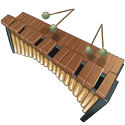|
So 5/12 is 5 notes that were triplet eighths in the previous 4/4? That makes sense. It's something that comes up pretty often in prog/technical music but whenever I've seen official transcriptions they just render it with a short-term tempo change (usually with a little header that says "quarter = dotted quarter" or whatever).
|
|
|
|

|
| # ? May 3, 2024 09:32 |
|
Any resources you recommend discussing harmonic rhythm? I've been having a hard time going beyond 4 bars 4 chord loops so want to see some theory about that to mix it up a bit
|
|
|
|
Jazz Marimba posted:It's actually not! Ooooooh this was a really good explanation because the whole concept finally clicked for me, thanks 
|
|
|
|
Simone Poodoin posted:Any resources you recommend discussing harmonic rhythm? I've been having a hard time going beyond 4 bars 4 chord loops so want to see some theory about that to mix it up a bit If we're talking classical theory, you can look at periods and sequences, which also encompasses the phrasing of the melody as well as harmonic rhythm. Periods are the typical question/response form. 2 bars question, 2 bars response. 2 bars repeated question, 2 bars different response. Each response ends in a cadence, and the second cadence has to be stronger than the first. So for example the first 'question' could use a bar of I, and a bar of V. Then the 'response' could have 2 chords per bar, maybe IV-I-ii-V, ending on a half cadence. Those four bars are your antecedent. Then the 'question' again (I-V), and this time the 'response' phrase ends with a perfect authentic cadence, 2 chords to a bar (VI-ii-V7-I). Those four bars are your consequent. The idea here is that the question phrases prolong being in the tonic, and the answer phrases have the candence. Put them together and you've got an 8 bar theme. Getting a bit more advanced, you can often use the antecedent to modulate as well, further widening your options for harmony. Sentences, the best example of this is Beethoven's Sonata no 1 in F minor. Start with a 2 bar phrase on one chord (as an example let's say I). Repeat that phrase in a different chord (for example V), altering the melody to fit the chord. Those 4 bars are the presentation phrase. Then pick a bar from that 2 bar phrase (usually the second bar) and repeat it in the previous two chords (this is called fragmentation), so you have I-I-V-V-I-V. That 6th bar could also be in a different chord so far unused. Just fit the melody around the chord. Then for the final 2 bars, come up with something to end the theme. The first of these bars is a simple melody releasing the tension over the first 2 chords of a cadence (this bar is called liquidation), and the final bar is the final chord of the cadence. These last 4 bars are called the continuation phrase. Like in the period, this cadence could be a half cadence ending on V, or a PAC ending on I, or hey you might have used bar 6 as a pivot chord and have a PAC in a new key. Generally, I found a good simple approach to harmonic rhythm is to start off slow, then accelerate towards the end of the theme. Having the cadences and modulations helps speed the harmonic rhythm up. And in the case of the sentence, fragmenting the melody helps with having to switch chords faster. Chord sequences don't need to be crazy and fast moving and using every chord under the sun either, pretty sure Beethoven just uses I and V two thirds of the time. Here's 2 videos from "Art Of Composing" that explain both theme types better than I've typed them. https://www.youtube.com/watch?v=3cWZCk4Co-s https://www.youtube.com/watch?v=1U4IOI5oYFY Konsek fucked around with this message at 22:12 on Apr 29, 2018 |
|
|
|
Thanks for the great post, will check out those videos
|
|
|
|
Jazz Marimba posted:Say we're playing a song that's in 4/4 and the verse are straight 8ths, but the choruses are going to be 5/12. So... I'm still thinking evil composers who want to mess with students' heads. I'm just kidding! You're explanation was great and I really appreciate it. I'll look around for examples to listen to. Given your username, solo marimba pieces can get pretty abstract. I'll look around! Thanks  To be honest by main apprehension towards an odd number on bottom was metalcore kids, years ago, who couldn't read music, telling me their garbage metalcore bands play in 5/7 time... And I'm like... Show me. And they're like, well... That was awhile ago. No excuse for my ignorance! I punish myself to 40 hours of Portraits In Rhythm and some Stick Control.
|
|
|
|
great thread! I got extremely interested in music theory after i saw this Jacob Collier thing (which i haven't seen posted yet) https://www.youtube.com/watch?v=DnBr070vcNE There are other videos of him on there as well. A summary of that he talks about is here: https://www.musidge.com/music/Jacob_Collier_Masterclass One of the things he says is that you can pick a root on the circle of fifths, and then either spool clockwise (in fifths) for a major sound, or spool anticlockwise (in fourths) for a minor sound.  My question: if that's a good way to think about harmony, how can I use the circle of fifths to reason about chords with augmented or diminished 5ths (like dom7 or min7b5)?
|
|
|
|
 this is what you get if you google "circle of tritones"
|
|
|
|
fzA455 posted:Given your username, solo marimba pieces can get pretty abstract. I'm actually a drummer, and can only play mallet instruments as a sloppy amalgam of my piano abilities and drum set technique! I only know a few solo mallet pieces, mainly from friends playing them, my favorite which I just looked up to share here...and I found out it was composed by a guy who lost most of his endorsements after going on a sexist rant on his Facebook artist page a couple months ago 
|
|
|
|
Got kind of a 'hum line'-like request... What are the time signatures of NIN's March of the Pigs and the pinball number song from Sesame Street? You know the one; the only lyrics are the numbers from 1 to 12.
|
|
|
|
Rupert Buttermilk posted:Got kind of a 'hum line'-like request... What are the time signatures of NIN's March of the Pigs and the pinball number song from Sesame Street? You know the one; the only lyrics are the numbers from 1 to 12. March of the Pigs is three measures of 7/8 grouped 2+2+3, and one measure of 8/8 grouped in 2s The pinball song was so difficult to figure out I just looked it up: en.m.wikipedia.org/wiki/Pinball_Number_Count edit: to clarify, it's mixed meter. they probably animated the scene and told the composers to write music to it, and that was the easiest way back then, before we had fancy computers that could math out that 4/4 at 124.65882bpm lines up all your hit points with beats Jazz Marimba fucked around with this message at 18:16 on Apr 30, 2018 |
|
|
|
Helianthus Annuus posted:great thread! A bit late, but this is a way over simplified way to think about harmony/chord progressions. Not 'bad' per se because it's really easy to improvise around the circle of 5ths. Ultimately you can get something that sounds good and it's fine, but there's no real deep understanding to be gained there. The book 'How Music Really Works' has a pretty good introductory chapter about chord progressions - and I think the book itself is a pretty well written intro to theory. It is geared towards songwriting more than anything, but the first few chapters are free online. Check it out: https://www.howmusicreallyworks.com/Pages_Chapter_6/Index_Chapter_6.html E: The author actually goes on a bit of a rant against using the circle of 5ths to guide progressions https://www.howmusicreallyworks.com/Pages_Chapter_6/6_7.html#6.7.7 Colonel Taint fucked around with this message at 20:57 on May 8, 2018 |
|
|
|
Did you seriously just call that Jacob Collier video simplistic and then post the equivalent Chords For Dummies? Collier wasn't even mostly talking about using the circle of fifth to guide progressions, he was talking about using it to add color notes to chords for the kind of dense-as-gently caress jazz harmonization stuff he does.
Trig Discipline fucked around with this message at 13:41 on May 9, 2018 |
|
|
|
I actually didn't really even watch the video - it was more a response to the post and that you're not going to get very far using the circle of fifths to reason about harmony.
|
|
|
|
Colonel Taint posted:I actually didn't really even watch the video - it was more a response to the post and that you're not going to get very far using the circle of fifths to reason about harmony. Cool so you’re replying to a video you didn’t even watch that’s not even about what you think it is. Clearly you know what you are talking about.
|
|
|
|
Why don't you take the stick out of your rear end? I'm not claiming to be an expert on anything - OP said they 'got extremely interested in theory after watching the video' so I assume they don't have much knowledge. Do you have a better answer?
|
|
|
|
Thanks for the recommendation, Taint. I am by no means an advanced music theory guy, so it helps to have these concepts explained to me multiple times using different words. From what I was able to read so far, How Music Really Works seems to be written so that it actually sticks in my silky-smooth brain. My only serious reading so far has been The Jazz Theory Book by Mark Levine, which I found to be useful in the context of functional harmony, but not-so-useful outside that domain. I have it in mind to eventually read Lydian Chromatic Concept of Tonal Organization by George Russell, but I've bounced off of it each time I tried to pick it up. My interest in music theory right now is figuring out how to make "working" harmony out of non-functional parts, like in Chrono Trigger OST, music by Disasterpiece, etc. I'm very into 8bit's youtube channel from the OP. The reason I posted Jacob Collier's poo poo is because I think he has a way of thinking about harmony that transcends the domain of "ii V I and friends". I would certainly appreciate it if you or others ITT could give it more serious consideration and comment intelligently on what he's saying.
|
|
|
|
This is way past my knowledge, but have you seen Adam Neely’s vid on musical brightness? https://youtu.be/9rEqrPwVITY The part around 1:15 in particular was pretty eye-opening for me. I had previously only known modes in relation to a major scale (C Ionian/Major, D Dorian, E Phrygian, etc.). Linking them all together with the same tonic in order of brightness to darkness (C Lydian, C Ionian/Major, C Mixolydian, etc.) made a lot of borrowed/color chords make more sense to me.
|
|
|
|
Colonel Taint posted:Why don't you take the stick out of your rear end? I'm not claiming to be an expert on anything - OP said they 'got extremely interested in theory after watching the video' so I assume they don't have much knowledge. Do you have a better answer? I was goofing on you for responding to a very advanced video that had a lot of the theory nerds freaking out for months with something pitched at a far lower level. You should watch the video and see what it is actually about, because it’s really interesting. He’s not talking about the circle of fifths in the way you clearly assumed he is, and the pattern he discusses contextualises some stuff that a lot of us “knew” intuitively about non-chord tones in a useful way. He also talks about the concept of negative harmony, which is goddamn insanity.
|
|
|
|
Know Such Peace posted:This is way past my knowledge, but have you seen Adam Neely’s vid on musical brightness? I saw this, but I'm still in the dark with how to apply it. I should mention that I'm a slacker guitarist, so I'm not used to thinking in terms of scales, but rather in terms of chords. I suspect this limitation is what's holding me back. Maybe you can elaborate on how you're able to apply the concepts he talks about in the video
|
|
|
|
Upon rewatching, I think I misunderstood his point to be honest. Hopefully someone else will be able to help. What I somehow got out of it was to arrange the seven modes of the major scale, except have them start on the same root note. Each scale flattens one note from the previous scale if you arrange it like Adam Neely did in that video. Using C as a root note, that gives you: C Lydian (#4 compared to Ionian/Major) C Ionian/Major (natural 4 compared to Lydian) C Mixolydian (b7 compared to Ionian/Major) C Dorian (b3 compared to Mixolydian) C Aeolian/Minor (b6 compared to Dorian) C Phrygian (b2 compared to Aeolian/Minor) C Locrian (b5 compared to Phrygian) Arranging these scales to fit major keys, their equivalents would be: C Locrian = G Major C Ionian/Major = C Major C Mixolydian = F Major C Dorian = Bb Major C Aeolian/Minor = Eb Major C Phrygian = Ab Major C Locrian = Db Major It's the circle of fifths. Borrowed chords seem to be synonymous with modal interchange, but I don't have any actual training so I'm not sure what the next step would be. I did think this exercise was a neat way to see how scales link together around the circle. Like I said at the beginning of this post, I don't think it was Adam Neely's intention in the vid.
|
|
|
|
Adam has this to say about modal interchange: https://www.youtube.com/watch?v=3n_mpcrMt1w&t=252s The TL;DR on that is that you can borrow a chord from a parallel minor key if it includes the b6 of that key, because b6 will want to resolve to the 5, which is a half-step away. That's why you see iv and bVI chords borrowed from the parallel minor when you're in a major key. I guess that's why it's really common to sub in a iv in place of the IV.
|
|
|
|
I think using modal interchange dominants tends to be frowned upon because the dominant seventh carries an expectation of resolution to a major chord - and so what you have isn't modal interchange, you have a modulation or some kind of key-of-the-moment. I don't know how much I agree with all that, but that's the explanation I've heard. So in C, you wouldn't see F7 as much as Fm7 because Fm7 doesn't suggest a modulation to a key of Bb, so goes the argument. So Adam Neely probably isn't wrong, I've just heard another reason why iv instead of IV tends to be a modal interchange.
|
|
|
|
yeah I think you're in the realm of secondary dominants if you're using a non-diatonic dom7 chord. Or if it's not a secondary dominant, maybe a tritone substitution. I think of those as different from modal interchange e: I think Adam is talking about the iv and bVI specifically because they're more likely to show up as borrowed chords vs like a II in a major key, or something like that. (E.g. a D major in the key of C major). For Adam, a II chord is possible, but undesirable because it lacks the b6 scale degree that makes the harmonic tension and resolution work. But by that logic, I'm guessing a bII or bii in a major key is possible and even desirable, because you get the b6 as the 5th in the chord. (E.g., Db major or Db minor in the key of C major; both chords have Ab as their 5th, and Ab is the b6 of C major). Or is there some reason this harmonic resolution idea works when your b6 is the root or the 3rd in your borrowed chord, but doesn't work as the 5th? Helianthus Annuus fucked around with this message at 01:02 on May 11, 2018 |
|
|
|
 does this help
|
|
|
|
Laserjet 4P posted:
ty so much
|
|
|
|
Here's Jeff Schneider using the doing some modal mixture with the bIII. https://www.youtube.com/watch?v=buZq5MX9Y8U Adam, a moron: it doesn't work b/c bIII is missing the b6 Jeff, a genius: if it sounds good, it is good
|
|
|
|
Adam: music theory is descriptive, not prescriptive. What sounds good is. Jacob Collier: is a (really cool) flash in the pan because he's the only person physically capable of playing his music
|
|
|
|
adam is very informative, but hes just such a smugdog. so even though i watch all his videos, its fun to see him get owned its also funny to watch JC win back-to-back grammys and struggle to fill time in his second acceptance speech in as many minutes https://www.youtube.com/watch?v=7ndgOS-fFkM
|
|
|
|
Cmin | D | Gmin/Bb | E | Amin | Cdim Ebdim | G | C# | F#min | D | Bmin | G | C | Amin | B | B | Okay so this is a chord sequence I've been listening to a lot recently, and I wondered if anyone had any ideas for how and why it works. The previous key was E major, and the final B chord acts as a dominant back into E. Konsek fucked around with this message at 21:42 on May 23, 2018 |
|
|
|
My guess is a lot of harmonic minor modulation (Cmin-D-Gmin is iv-V-i in G, and i-V is classic harmonic/melodic minor), followed by an A V-i. I don't really know what Cdim-Ebdim-G-C# is, but I suspect Cdim-Ebdim is some kind of baroque thing. F#min-D-Bm-G is a D major sequence, and G acts as a pivot chord towards C, and Am acts as a pivot chord back towards E minor since Am-B both are diatonic to E harmonic minor. In short I don't know, but it's unconventional, and I like it.
|
|
|
|
The diminished chords are inversions of each other, effectively making it a rootless D7(b9) V7-I transition to G. Not sure how G then connects to C# tho. Edit: Neapolitan Chord maybe? I’m unfamiliar with them unfortunately. Second Edit: Is it a piece that already exists or is it something you are working on? Could you link it? It sounds nice overall, but the C# feels really abrupt in my opinion. It may work better in context though. Know Such Peace fucked around with this message at 05:27 on May 24, 2018 |
|
|
|
Know Such Peace posted:The diminished chords are inversions of each other, effectively making it a rootless D7(b9) V7-I transition to G. Not sure how G then connects to C# tho. G to C# works because of voice leading--two notes are identical and the other two move by step. Technically it's a Neapolitan chord following the original, but Neapolitan chords are used as a replacement of the chord.
|
|
|
|
Konsek posted:Cmin | D | Gmin/Bb | E | Amin | Cdim Ebdim | G | C# | can i listen to this in context please?
|
|
|
|
The chord sequence comes from Gates of Babylon by 70s rock band Rainbow. It's the backing for a pretty epic guitar solo. Just before this is another guitar solo (at 3:00) which switches between E double harmonic major and some other E scales, in fact most of the song uses E double harmonic major (1, b2, 3, 4, 5, b6, 7) and phrygian domninant, which is pretty awesome. I particularly like the Cdim Ebdim G sequence, though, definitely stealing that. In fact that whole Amin | Cdim Ebdim | G | C# | F#min bit is awesome as it incorporates my 2 of my favourite things, diminished chords and neapolitan chords. Jazz Marimba posted:G to C# works because of voice leading--two notes are identical and the other two move by step. Technically it's a Neapolitan chord following the original, but Neapolitan chords are used as a replacement of the chord. If it goes from G to C# to F#min, isn't it the G that is the neapolitan chord? In which case it's in the normal order. This video starts on the Am chord that precedes the chord sequence (the sequence loops twice). https://www.youtube.com/watch?v=MHCdCbTxypU&t=220s Konsek fucked around with this message at 23:23 on May 28, 2018 |
|
|
|
do Neapolitan chords occur when the tonic is minor? G-C#-F# is a progression where G is absolutely Neapolitan, since it's supposed to function as a pre-dominant, but I have no idea if it works when F# is F#m instead. I guess I don't really see why it wouldn't. Although since you mentioned it was Rainbow, I kind of suspect the driving force behind the whole thing is "this sounds really good together".
|
|
|
|
In my experience, neapolitan chords are more common in minor keys, but as you say, it works in both. The guitarist and the keyboardists he worked with definitely have at least some classical knowledge, it's evident all over early Deep Purple and Rainbow. However, what I find fascinating is that even if something is written just because the musician thinks "this sounds really good together", you can very often work out why after the fact, and replicate it purposefully. Which is something that makes music theory so powerful.
|
|
|
|
i'm just BARELY starting out with theory and i've been dicking around with modal interchange and i have a question: where do major 6th and 6/9 chords usually fit in a chord progression? my primary instrument is banjo, and the banjo has a fairly simple major 6th chord voicing and it sounds absolutely beautiful on the instrument, but there are very few cases when i'm writing a chord progression and the 6th chord just screams out to me "put me in this poo poo", which is a shame imo like II6 - I is a neat little cadence, but i'm lookin for more examples of "classic" or "idiomatic" use cases of maj6 chords
|
|
|
|
For variety? Where they'd fit diatonically (i.e. a 6 chord can be played in any major chord in the diatonic scale - including over a dominant for that sexy 13 sound) ? Maybe for voice leading smoothness?
|
|
|
|

|
| # ? May 3, 2024 09:32 |
|
I6 chords used to be where Imaj7 chords are used now, so they can generally be used interchangeably. People started using the maj7 because it was a little more harmonically interesting but it's so ubiquitous now that I ironically prefer the 6th instead. I6/9 are often used at the end of phrases/songs.
|
|
|






















